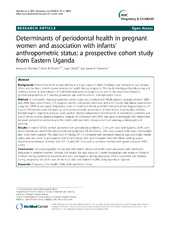| dc.contributor.author | Wandera, Margaret Nekesa | en_US |
| dc.contributor.author | Åstrøm, Anne Nordrehaug | en_US |
| dc.contributor.author | Okullo, Isaac | en_US |
| dc.contributor.author | Tumwine, James K. | en_US |
| dc.date.accessioned | 2013-05-16T11:03:56Z | |
| dc.date.available | 2013-05-16T11:03:56Z | |
| dc.date.issued | 2012-09-05 | eng |
| dc.Published | BMC Pregnancy and Childbirth 2012, 12:90 | eng |
| dc.identifier.issn | 1471-2393 | |
| dc.identifier.uri | https://hdl.handle.net/1956/6621 | |
| dc.description.abstract | Background: Preterm-low birth weight delivery is a major cause of infant morbidity and mortality in sub Saharan Africa and has been linked to poor periodontal health during pregnancy. This study investigated predisposing and enabling factors as determinants of oral health indicators in pregnancy as well as the association between periodontal problems at 7 months gestational age and the infants’ anthropometric status. Method: A community –based prospective cohort study was conducted in Mbale, Eastern Uganda between 2006 and 2008. Upon recruitment, 713 pregnant women completed interviews and a full mouth oral clinical examination using the CPITN (Community Periodontal Index of Treatment Need) and OHI-S (Simplified Oral Hygiene) indices. A total of 593 women were followed up with anthropometric assessments of their infants 3 weeks after delivery. Multiple logistic regression analyses were used to identify independent determinants of periodontal problems and use of dental services during pregnancy. Analysis of covariance (ANCOVA) was used to investigate the relationship between periodontal problems and the child’s anthropometric status in terms of wasting, underweight and stunting. Results: A total of 67.0% women presented with periodontal problems, 12.1% with poor oral hygiene, 29.8% with recent dental visit and 65.0% with periodontal symptoms. Of the infants, 2.0% were wasted, 6.9% were underweight and 10.0% were stunted. The odds ratio of having CPI > 0 increased with increased maternal age and single marital status, and was lower in primiparous women and those who used mosquito bed nets. Mean wasting scores discriminated between mothers with CPI = 0 and CPI > 0 as well as between mothers with good and poor OHI-S scores. Conclusions: Socio-demographic factors and information about oral health were associated with oral health indicators in pregnant women. Second, the height- for- age status at 3 weeks postpartum was worse in infants of mothers having periodontal problems and poor oral hygiene during pregnancy. Efforts to prevent oral diseases during pregnancy should be part of the local state and national health policy agenda in Uganda. | en_US |
| dc.language.iso | eng | eng |
| dc.publisher | BioMed Central | eng |
| dc.rights | Attribution CC BY | eng |
| dc.rights.uri | http://creativecommons.org/licenses/by/2.0 | eng |
| dc.subject | Pregnancy | eng |
| dc.subject | Oral health | eng |
| dc.subject | Anthropometric status | eng |
| dc.title | Determinants of periodontal health in pregnant women and association with infants’ anthropometric status: a prospective cohort study from Eastern Uganda | en_US |
| dc.type | Peer reviewed | |
| dc.type | Journal article | |
| dc.description.version | publishedVersion | en_US |
| dc.rights.holder | Copyright 2012 Wandera et al.; licensee BioMed Central Ltd. | |
| dc.identifier.doi | https://doi.org/10.1186/1471-2393-12-90 | |
| dc.identifier.cristin | 986484 | |
| dc.source.journal | BMC Pregnancy and Childbirth | |
| dc.source.40 | 12 | |

